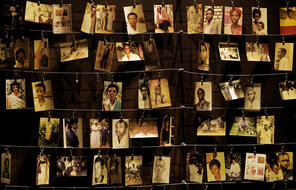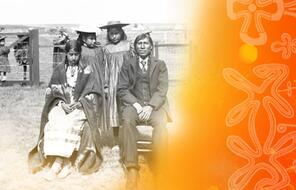The Charge of Genocide
In the 1990s, residential schools scholars such as James R. Miller and many indigenous leaders began to argue that the efforts of the Canadian government to assimilate the Indigenous Peoples in the residential schools embodied the principle of cultural genocide: assimilation was intended to destroy the Indigenous Peoples as culturally distinct group. 1 Other scholars pushed back, noting that the cultural destruction of a group is not included as genocide in the final version of the UN Genocide Convention. 2 The debate has continued since then and, if anything, has gained momentum: What is the proper way to address the near-destruction of Indigenous Peoples, their languages, and their cultures? What is the government’s culpability?
More and more activists, scholars, and community leaders now call on the government to acknowledge those policies as genocide even if mass killings did not take place in Canada. 3 As evidence, they list policies such the suppression of indigenous languages and cultures in residential schools, the forced removal of children in the 1960s and 1970s from indigenous families, and the fatal neglect of students in the residential schools system. The debate surrounding this issue raises many questions. What is at stake for Indigenous Peoples? Why is the government reluctant to call it genocide? Why do some groups deny that this classification should apply to the operation of the Indian Residential Schools? 4 (For more on this complex debate, see Chapter 7 of this guide.)
First things first: How was the term genocide originally construed? For Raphael Lemkin, the Polish Jewish jurist who coined the term, the cultural destruction of a group was as important as the physical annihilation of its members. Early in the 1930s, Lemkin went to great lengths to expand his definition of the crime he later called genocide beyond the physical destruction of human beings. “Our whole heritage is a product of the contributions of all nations,” he argued in a 1933 paper. For him, the destruction of cultural groups was in fact an assault on humanity itself if, indeed, humanity is the sum total of cultures of the world. So he added another element to his notion of what group destruction meant: the “systematic and organized destruction of the art and cultural heritage in which the unique genius and achievement of a collectivity are revealed in fields of science, art and literature.” 5
Many scholars turn for guidance to the UN’s Convention on the Prevention and Punishment of the Crime of Genocide, 1948 (the Genocide Convention). In Article 2, it defines genocide as:
any of the following acts committed with intent to destroy, in whole or in part, a national, ethnical, racial or religious group, as such:
(a) Killing members of the group;
(b) Causing serious bodily or mental harm to members of the group;
(c) Deliberately inflicting on the group conditions of life calculated to bring about its physical destruction in whole or in part;
(d) Imposing measures intended to prevent births within the group;
(e) Forcibly transferring children of the group to another group. 6
When Canada ratified the convention, government officials held that it was designed to address crimes committed in Europe, and especially the Holocaust. 7 As a result, Canada rejected several of the key articles. But despite the lack of Canadian legislation on this issue, scholars, indigenous activists, and community leaders maintain that Article 2(e) seems particularly relevant. They argue that the Indian Residential Schools, along with the Sixties Scoop, when thousands of indigenous children were removed from their own families, were in fact attempts to transfer children from one group to another. 8
Other scholars suggest that the UN’s definition is not sufficiently expansive. They argue that the physical destruction of a group should not be the only factor that defines genocide. A group whose political, cultural, and economic structures are denied or destroyed cannot continue to exist as a distinct group. When the things that give a group its collective identity are gone, the group ceases to exist. 9 Similarly, some argue that if a group’s distinctive cultural integrity is destroyed, it can no longer exist as a group. By that logic, since the whole purpose of the Genocide Convention was to criminalize the destruction of groups, what happened in colonial Canada does amount to genocide. Indeed, as we saw above, this is what Lemkin was getting at. Sociologist Andrew Woolford of the University of Manitoba in Winnipeg summarizes this view:
If genocide should be understood as the “destruction of group life rather than lives within a group,” then in the case of Canada’s indigenous peoples, that means understanding what makes them a group, what defines their cultural cohesion, such as a profound attachment to the land and nature. So, in Canada’s colonial past, systematically depriving First Nations of access to their land so European pioneers could settle and railways could be built, is genocidal. 10
The argument about cultural genocide relates directly to the issue at the heart of this guide: the Indian Residential Schools. More and more critics contend that the colonial efforts of assimilation—the undisputed goal of the residential schools—violated the laws of genocide. 11 Meanwhile, others continue to note that the cultural destruction of a group is not defined in the UN Genocide Convention as genocide. (Cultural genocide was excluded from the Genocide Convention because of the objections of Australia, the United States, the United Kingdom, Canada, and France, among other countries.) 12
Additional problems surround the way genocide is construed: namely, the idea that it is an intentional, orchestrated scheme to destroy a group in whole or in part. 13 “Evidence of the clear intent to destroy is elusive when it comes to making the case for Canadian settler-colonial genocide,” writes Adam Muller of the University of Manitoba in Winnipeg, but “this is not to say it is wholly absent.” 14 Indeed, many point to the writings of Duncan Campbell Scott, who was in charge of the Indian Residential Schools from 1909 to 1932 (in several capacities). 15 In 1910 he stated that “it is readily acknowledged that the Indian children lose their natural resistance to illness by habitating so closely in the schools, and that they die at much higher rates than in their villages. But this alone does not justify a change in the policy of this department, which is geared toward the final solution to the Indian problem.” 16 Scott’s “final solution” was assimilation, not physical destruction, which for genocide scholars means that the term genocide must be either qualified as the crime of “cultural genocide” or changed in meaning altogether.
For many, the 2015 Final Report of the Truth and Reconciliation Commission seemed to have settled the debate. This national body declared that “the establishment and operation of residential schools were a central element of this policy, which can best be described as ‘cultural genocide.’” The authors of the Final Report explained:
States that engage in cultural genocide set out to destroy the political and social institutions of the targeted group. . . . Languages are banned. Spiritual leaders are persecuted, spiritual practices are forbidden, and objects of spiritual value are confiscated and destroyed. And, most significantly to the issue at hand, families are disrupted to prevent the transmission of cultural values and identity from one generation to the next. . . . The Canadian government pursued this policy of cultural genocide because it wished to divest itself of its legal and financial obligations to Aboriginal people and gain control over their land and resources. If every Aboriginal person had been “absorbed into the body politic,” there would be no reserves, no Treaties, and no Aboriginal rights. 17
There will be more discussion of these issues and questions in Chapter 7 .
- 1James R. Miller, Shingwauk’s Vision: A History of Native Residential Schools (Toronto: University of Toronto Press, 2012), 9–10.
- 2Cultural genocide was included in the first draft of the Genocide Convention but was taken out because of objection from Australia, the United States, the United Kingdom, Canada, and France. See Shamiran Mako, “Cultural Genocide and Key International Instruments: Framing the Indigenous Experience,” International Journal on Minority and Group Rights 19 (2012), 183; First draft of the Convention on the Prevention and Punishment of the Crime of Genocide, prepared by UN Secretariat, [May] 1947 [UN Doc. E/447].
- 3Andrew Woolford, Jeff Benvenuto, and Alexander Laban Hinton, “Introduction,” in Colonial Genocide in Indigenous North America, (Durham: Duke University Press, 2014), 5–7.
- 4For information about the debate on this issue in recent years, see A. Dirk Moses, “Does the Holocaust Reveal or Conceal Other Genocides? The Canadian Museum of Human Rights and Grievable Suffering,” in Alexander Laban Hinton, Thomas la Points, and Douglas Irvin-Erickson, Hidden Genocide (New Brunswick, NJ: Rutgers University Press, 2014), 21–51.
- 5Raphael Lemkin, “Acts Constituting a General (Transitional) Danger Considered as Offense against the Law of Nations,” Prevent Genocide International website, accessed October 10, 2015. Also quoted and discussed in Facing History and Ourselves, Totally Unofficial: Raphael Lemkin and the Genocide Convention (Brookline: Facing History and Ourselves, 2007), 11–15.
- 6Convention on the Prevention and Punishment of the Crime of Genocide, Paris, 9 December 1948, United Nations website, accessed October 8, 2014. For more information, see Facing History and Ourselves, Totally Unofficial: Rafael Lemkin and the Genocide Convention (Brookline: Facing History and Ourselves, 2007).
- 7David MacDonald explains, “When Canada [ratified] the UNGC in 1952, we did so highly selectively. Portions of the Convention were excluded from the Criminal Code, such that genocide still means only Article 2 (a) and (b). The official reasons given to parliament . . . was that [the] portions of the UNGC ‘intended to cover certain historical incidents in Europe that have little essential relevance to Canada’ could safely be omitted. They even asserted that ‘mass transfers of children to another group are unknown . . . in Canada.’” See David B. MacDonald, “Genocide in the Indian Residential Schools: Canadian History through the Lens of the UN Genocide Convention,” in Woolford, Benvenuto, and Hinton, Colonial Genocide in Indigenous North America, (Durham: Duke University Press, 2014 ), 309.
- 8David B. MacDonald and Graham Hudson, “The Genocide Question and the Indian Residential School in Canada,” Canadian Journal of Political Science 45 (2012), 428; Adam Muller, “Troubling History, Troubling Law: The Question of Indigenous Genocide in Canada,” forthcoming.
- 9Norbert Elias, Society of Individuals, trans. Edmund Jephcott (New York: The Continuum International Publishing Group, 2001), 183–84, 196–97. For Elias, the balance between a person’s we-identity and I-identity is reflective of the society in which he or she lives, so that in more traditional societies the former is stronger, while modern identity veers toward the I-identity.
- 10Quoted (from interview) in Mary Agnes Welch, “The Genocide Test,” Winnipeg Free Press, July 12, 2014.
- 11James Miller, Shingwauk’s Vision, 9–10.
- 12Shamiran Mako, “Cultural Genocide and Key International Instruments: Framing the Indigenous Experience,” International Journal on Minority and Group Rights 19 (2012), 183.
- 13The issue of intentionality is discussed in David B. MacDonald, “Where Are Canada’s History Wars? Indigenous Genocide and Public Memory in Australia, the United States, and Canada,” forthcoming.
- 14Adam Muller, “Troubling History, Troubling Law: The Question of Indigenous Genocide In Canada,” forthcoming.
- 15Magen Sproule-Jones, “Crusading for the Forgotten: Dr. Peter Bryce, Public Health, and Prairie Native Residential Schools,” Canadian Bulletin of Medical History 13 (1996), 217–218.
- 16Quoted in Anthony Hall, Earth into Property: Colonization, Decolonization, and Capitalism (Montreal/Ontario: McGill- Queen’s University Press, 2010), 676.
- 17“Honouring the Truth, Reconciling for the Future,” Executive Summary of the Final Report of the Truth and Reconciliation Commission of Canada (The Truth and Reconciliation Commission of Canada, 2015), 1–3. Emphasis added.












